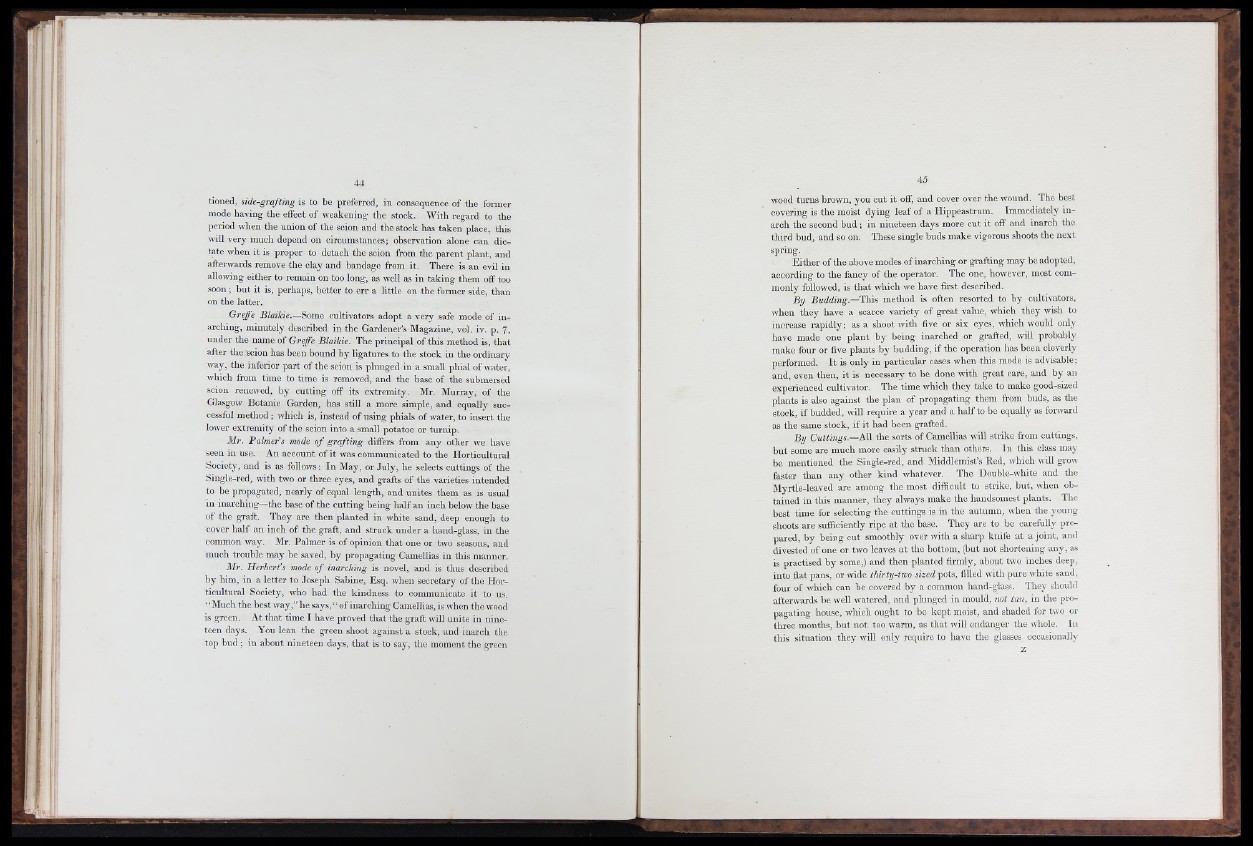
tioned, side-graftmg is to be preferred, in consequence of the former
mode having th e effect of weakening the stock. With reg-ard to the
period when the union of the scion aud the stock has taken place, this
will very much depend on circumstances; observation alone can dictate
when it is proper to detach the scion from the parent plant, and
afterwards remove the clay and bandage from it. There is an evil in
allowing either to remain on too long, as well as in tak in g them off too
so o n ; b u t it is, perhaps, better to err a little on th e former side, than
on the latter.
Greffe RZaiArie.—Some cultivators adopt a very safe mode of inarching,
minutely described in the Gai'deuer’s Magazine, vol. iv. p. 7,
u nder the name of G re fe Blaikie. The principal of this method is, th a t
after the scion has been bound by ligatures to the stock in the ordinary
way, the inferior part of the scion is plunged in a small phial of water,
which from time to time is removed, and the base of th e submersed
scion renewed, by cutting off its extremity. Mr. Murray, of the
Glasgow Botanic Garden, has still a more simple, and equally successful
method ; which is, instead o f using phials of water, to insert the
lower extremity of the scion into a small potatoe or turnip.
Mr. Palmer’s mode o f g rafting differs from any other we have
seen in use. An account of it was communicated to the Horticultural
Society, and is as follows: In May, or Ju ly , he selects cuttings of the
Single-red, ivith two or three eyes, and grafts of the varieties intended
to be propagated, nearly of equal length, and unites them as is usual
in inarching—the base of the cutting being half an inch below the base
of the graft. They are then planted in white sand, deep enough to
cover half an inch of the graft, and struck under a hand-glass, in the
common way. Mr. Palmer is of opinion th a t one or two seasons, and
much trouble may be saved, b y propagating Camellias in this manner.
Mr. Herbert’s mode o f inarching is novel, and is thus described
by him, in a le tte r to Joseph Sabine, Esq. when secretary of the Horticultural
Society, who had the kindness to communicate it to us.
‘ ‘ Much the best way,” he says, ‘ ‘ o f inarching Camellias, is when the wood
is green. At th a t time 1 have proved th a t the graft will unite in nineteen
days. You lean the green shoot against a stock, and inarch the
top bud ; in about nineteen days, th a t is to say, the moment the green
wood turns brown, you cut it off, and cover over the wound. The best
covering is the moist dying leaf of a Hippeastrum. immediately in arch
the second bud ; in nineteen days more cu t it off and inarch the
third bud, and so on. These single buds make vigorous shoots th e next
spring.
Eith e r of th e above modes of inarching or grafting may be adopted,
according to th e fancy of the operator. The one, however, most commonly
followed, is th a t which we have first described.
B y Budding.—Thiis, method is often resorted to by cultivators,
when th ey have a scarce variety of great value, which they wish to
increase rapidly; as a shoot with five or six eyes, whicli would only
have made one p lan t b y being inarched or grafted, will probably
make four or five plants b y budding, if the operation has been cleverly
performed. I t is only in particular cases when this mode is advisable;
and, even then, it is necessary to be done with great care, and b y an
experienced cultivator. The time which they take to make good-sized
plants is also against th e plan of propagating them from buds, as the
stock, if budded, will require a yea r and a h a lf to be equally as forward
as the same stock, if it had been grafted.
B y C u ttin g s .~ A \\ th e sorts of Camellias will strik e from cuttings,
b u t some are much more easily struck th an others. In this class may
be mentioned the Single-red, and Middlemist’s Red, which will grow
faster th an an y other k ind whatever. The Double-white and the
Myrtle-leaved are among the most difficult to strike, b u t, when obtained
in this manner, they always make the handsomest plants. The
best time for selecting the cuttings is in th e autumn, when the young
shoots are sufficiently ripe a t tlie base. They are to be carefully prepared,
by being cut smoothly over with a sharp knife a t a joint, and
divested of one or two leaves a t th e bottom, (but not shortening any, as
is practised by some,) and then planted firmly, about two inches deep,
into flat pans, or wide thirty-tz&o sized pots, filled with pure white sand,
four of which can be covered by a common hand-glass. They should
afterwards be well watered, and plunged in mould, not tan, in the propagating
house, which ought to be k ep t moist, and shaded for two or
three months, b u t not too wami, as th a t will endanger the whole. In
this situation they will only require to have the glasses occasionally